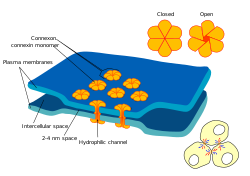Gap junction
| Gap junction | |
|---|---|

Gap junction
|
|
| Identifiers | |
| MeSH | Gap+Junctions |
| TH | H1.00.01.1.02024 |
| FMA | 67423 |
|
Anatomical terminology
[]
|
|
A gap junction may also be called a nexus or macula communicans. When found in neurons or nerves it may also be called an electrical synapse. While an ephapse has some similarities to a gap junction, by modern definition the two are different.
Gap junctions are a specialized intercellular connection between a multitude of animal cell-types. They directly connect the cytoplasm of two cells, which allows various molecules, ions and electrical impulses to directly pass through a regulated gate between cells.
One gap junction channel is composed of two connexons (or hemichannels), which connect across the intercellular space. Gap junctions are analogous to the plasmodesmata that join plant cells.
Gap junctions occur in virtually all tissues of the body, with the exception of adult fully developed skeletal muscle and mobile cell types such as sperm or erythrocytes. Gap junctions, however, are not found in simpler organisms such as sponges and slime molds.
In vertebrates, gap junction hemichannels are primarily homo- or hetero-hexamers of connexin proteins. Invertebrate gap junctions comprise proteins from the innexin family. Innexins have no significant sequence homology with connexins. Though differing in sequence to connexins, innexins are similar enough to connexins to state that innexins form gap junctions in vivo in the same way connexins do. The recently characterized pannexin family, which was originally thought to form inter-cellular channels (with an amino acid sequence similar to innexins), in fact functions as a single-membrane channel that communicates with the extracellular environment, and has been shown to pass calcium and ATP.
...
Wikipedia
